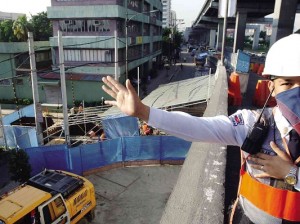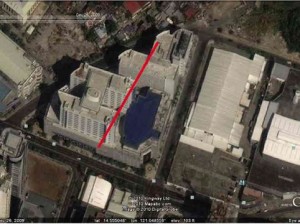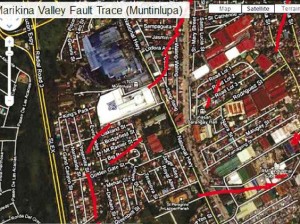Oil, gas leaks in fault zones

EXPLOSION AFTERMATH An apartment in Serendra, an upscale condominium building in Bonifacio Global City, suffered severe damage as a result of an explosion believed to be caused by a gas leak. Photo by CARLO A. ARCILLA/CONTRIBUTOR
What do the massive oil leak in Barangay Bangkal, Makati, and the Serendra explosion in Bonifacio Global City, believed to be caused by a gas leak, have in common? Pipelines in areas with geologic faults.
This past month marked the third anniversary of the discovery of the leak in the First Philippine Industrial Corp. (FPIC) pipeline—more than 2 million liters of petroleum products, roughly a fourth of which flowed into the basement of the West Tower condominium.
Article continues after this advertisement
Contaminated

OIL LEAK Some 2 million liters of petroleum products from a ruptured section of the 117-kilometer FPIC pipeline leaked into the soil of Barangay Bangkal, Makati. About 500,000 liters flowed into the basement of the West Tower building. INQUIRER PHOTO
Roughly 400,000 liters of the petroleum products (gasoline, diesel, kerosene and aviation gas) spill remain underground, contaminating and mixing with the soil and water beneath Bangkal.
Article continues after this advertisementFPIC has undertaken an aggressive cleanup process called multiphase extraction system comprising a set of recovery wells, which are treating 500,000 liters of contaminated water per day.
It is important to distinguish between the leak in the pipeline and the subsequent underground contamination that this leak has produced. There are tests that have demonstrated that the leak in the pipeline is already repaired.
Far from over
But the cleanup operation to decontaminate the soil and groundwater of carcinogenic benzene (among other pollutants) is far from over because the groundwater in Bangkal has to be cleaned up to at least
5 parts-per-billion of benzene, which is the threshold level for this chemical to be carcinogenic if imbibed by humans.
Three long years and not one of the more than 100 families displaced by this leak have gone back to their homes. This affair has mutated from a contamination issue into highly entangled legal cases. Cynically, it will be the lawyers who will make hay from this disaster.
On May 31, a similar case occurred—the Serendra gas leak explosion, which killed four people, including Angelito San Juan, 63, who bore the brunt of the explosion. The initial findings suggest that a gas leak was responsible for the explosion, but the definitive report is still to come. (I chose not to comment on the Glorietta explosion because we were not involved in its investigation.)
Similarities

BUILDING SITTING ON A FAULT A structure in Bonifacio Global City was built right on a geological fault (red line). Contributed photo
Are there similarities between these leaks that we can learn from? The differences are obvious, but there are similarities that could offer opportunities for learning.
In Bangkal, even if the leak was not from a gas pipe, the sheer amount of leaked liquid fuel into the four-story basement of West Tower created a huge volume of evaporated explosive gas mixture that needed only oxygen and a spark to cause an explosion. We are very, very lucky that an explosion did not happen in West Tower because the volume of explosive gases was a lot more than what a small room in Serendra could accommodate.
Just a small volume of explosive gas was able to push a concrete slab in Serendra—it is unimaginable what the four-basement volume of explosive gases in West Tower could have damaged had it exploded.
A big part of the credit here should be given to the late city engineer of Makati, Nelson Morales, and Makati Mayor Junjun Binay for the decisive and probably then unpopular decision to forcibly evacuate more than 100 families from West Tower in the wee hours of the morning of July 2010.
In hindsight, from the Serendra situation, this was a very wise decision. The unfortunate situation of these families not yet returning to their homes not only involves technical issues but also complex legal cases that may take years to resolve. Detecting leaks in pipes is not easy, as the Bangkal incident has shown, and gas pipelines are even more difficult to handle.
Learning from accidents

MALL ON A QUAKE FAULT A mall sits on well-documented fissures (red lines) in Muntinlupa City, part of the West Marikina Valley Fault. Contributed photo
Every two years, a pipeline conference is held in Banff, Canada, which discusses accidents worldwide. While pipelines disasters are relatively rare (and which make them still safer than the alternative of transporting fuel on land and on wheels), these accidents are discussed in gory detail in this conference in order to learn from them.
One big difference in managing a liquid fuel pipeline and gas pipelines is that access to the former is highly restricted. Once gas is distributed, access to gas lines, especially into individual homes, is almost beyond the control of the pipeline operator.
The source of the leak in the FPIC pipeline was pinpointed after considerable work, but the source of the leak in the gas pipeline in Serendra, (if it was a leak in the first place) especially after the explosion, would be much more difficult to trace.
From this perspective, it is understandable that the Ayala Land management has decided to suspend gas operations in Serendra units because monitoring local control of gas flow and making individual users comply with safety regulations are difficult. But it must be mentioned that in most developed countries, gas delivery into homes by pipeline is almost standard practice.
If one were to really compile statistics, I would not be surprised that more people and fires have been caused by defective gas canisters than by gas pipelines in the Philippines. Just to add to the data, the recent horrendous accident in Canada, where a train carrying oil (because there were no pipelines in the area) and catching fire that almost destroyed a whole town, accentuates the overall safety of pipelines compared with the surface transport of fuel.
West Marikina Valley Fault
When we investigated the cause of the FPIC pipeline leak, we realized then that the 117-kilometer pipeline would cross the active West Marikina Valley Fault in several places. To evaluate the risk of the pipe being damaged by the faults, we drilled dozens of exploratory holes in the vicinities of the suspected intersections to check for leaks. Luckily, none were found.
This may be due to the combined strength and flexibility of the reinforced steel pipe used in the FPIC pipeline, which even if intersecting an active fault, “bends but not breaks.”
These fault-intersected portions of the pipelines will need careful monitoring just to make sure they don’t leak in the future.
Buildings on a fault
In Bonifacio Global City, National Institute of Geological Sciences (NIGS) researchers earlier raised the issue of a previously unmapped fault underlying some buildings not far from Serendra. While it remains to be proven if these faults are active or if they are connected to the nearby West Marikina Valley Fault trace (which are clearly active), their directly underlying structures pose risks that should be of safety concern if the public passes through these buildings.
Is Bonifacio Global Gas aware that some of its gas lines could be intersecting the fault? For safety’s sake, this aspect should be ruled out. (While we are at it, not only gas lines would be at risk but also the structural safety of buildings built right on top of potentially active faults.)
Just to demonstrate the concept, the Santolan underpass of the C5 highway crosses the active part of the West Marikina Valley Fault. Even if the chances of the underpass collapsing are small, one notices leaks on the walls of the underpass, suggesting that fault activity may have damaged some pipes crossed by the fault in this vicinity.
Hundreds of structures
I would be very happy to be proven wrong on the dangers of building on top of faults. Geologists have known for some time that probably hundreds of structures are directly sitting on active segments of the West Marikina Valley Fault and the main traces of this active fault are in fact on the website of the Philippine Institute of Volcanology and Seismology [Phivolcs] (phivolcs.dost.gov.ph).
Many of us are convinced that if one builds a few meters away from an active fault, the risks are not different from buildings built maybe 500 meters away once an earthquake happens—the main factor that will ensure safety is the robust construction of the building.
However, there is no engineering remedy for a building that is built right on the fault should this move substantially, causing an earthquake, simply because the fault plane is much, much deeper than the tallest buildings (it can be several kilometers deep).
In fact, it is not good business to locate faults because geologists can be perceived as “fault finders” (in the real sense of the word) and no one wants to pay the bearer of bad news. Just for comparison, however, in California buildings that are built right on top of the San Andreas Fault are required by law to have a sign in front stating clearly that it is built on the fault and warning potential buyers of this risk!
An important building in Bonifacio Global City has been found to be built on a fault. The building should be monitored to document if the fault is indeed active. (See photo.)
In Muntinlupa City, a mall was constructed on top of an active fault. (See photo.) Why was this building given permission to construct or how was it able to justify its environmental impact assessment, which requires fault studies?
Right equipment
In the Bangkal and Serendra incidents, we note with urgent concern the absence of essential tools like gas detectors to equip our firemen and investigators. Our group has portable gas detectors and explosivity meters in order to do our duties at the Bangkal leak, courtesy of the Makati government.
I found it sad that members of the scene of the crime operatives and firemen who rushed to Serendra after the explosion did not have these essential meters, which could have helped pinpoint the cause or causes of the explosion and even served as safety tools for the investigators themselves.
We should be aware of the risks that these firemen and investigators undergo when they look into a fresh crime or accident scene and we owe it to them that they are properly equipped.
We were called to do gas measurements days after the explosion only because we have the equipment. Our laboratories at NIGS also have assorted spectrometers (XRD, XRF, MPAES, ICPMS and LA-ICPMS) that could help in forensic appraisals, but the police and investigative bodies should have these equipment to help them in their work.
Foreign experts, again
It is equally lamentable to note that Interior Secretary Mar Roxas has been reportedly forced to “go to foreign experts” to help solve the Serendra explosion. Even if it is probably true that we don’t have frequent explosions of this sort here, I would argue that we have enough local scientists and engineers to shed light on these problems.
Unfortunately, there is a local tendency to run to “foreign experts” to seek justification for the unjustifiable! In the case of the West Tower incident, the foreign experts who were hired by FPIC to say that the pipeline was not leaking were simply wrong and we proved them wrong even if they were paid a very handsome amount!
In Serendra’s case, while not prejudging the foreign experts’ findings, I would be very interested to know if they can answer why, for example, did the victim not smell the excessive gas buildup when he entered the room, and why did the gas sensors not work? Was the piped gas not spiked with mercaptans so that they can be humanly detected?
How could the experts know this days or weeks after the incident?
Scientific backbone
What we need is to strengthen our scientific backbone in solving not only disasters but also many phenomena. While it may be true that in this situation the abilities of foreign experts are needed to help solve the Serendra problem, it reinforces the false notion that our local experts are not capable enough to handle such situations.
Being a balikbayan scientist who obtained a doctorate in the United States, one cannot help but question this attitude of turning to foreign experts when some of us have the same and even better qualifications than these foreigners who will only be here for a short time and will not have to face the responsibility for wrong advice!
Colonial mentality
Unfortunately, this aspect of colonial mentality and lack of scientific reliance are ingrained in our society. For example, many rich customers of condominiums first consult expensive feng shui experts instead of geologists who could help evaluate potential hazards in their homes. (The two may not necessarily be mutually exclusive!)
My common sense advice to my students and friends, who are looking for sites for their new homes and businesses, include looking at the actual site in the worst weather (during floods, landslides and strong rain) before buying a property, and checking the locations against the website of Phivolcs for potential fault locations and nababaha.com for potential flooding dangers.
The logic here is obvious: Before we buy a T-shirt in Divisoria (which costs more or less P100), we check if there are holes and defects, and if the size fits right. What more if we are going to buy something for a lifetime investment like a home, which costs millions?
The mantra of the scientific method, which I hope gets to become second nature to our citizens is: Verify, verify, verify! As the saying goes: An ounce of prevention is worth more than a pound of cure.
(Carlo A. Arcilla is a professor at and director of the National Institute of Geological Sciences, UP Diliman. He holds master’s and doctoral degrees in geotechnical engineering and geosciences from the University of Illinois in Chicago.)
















